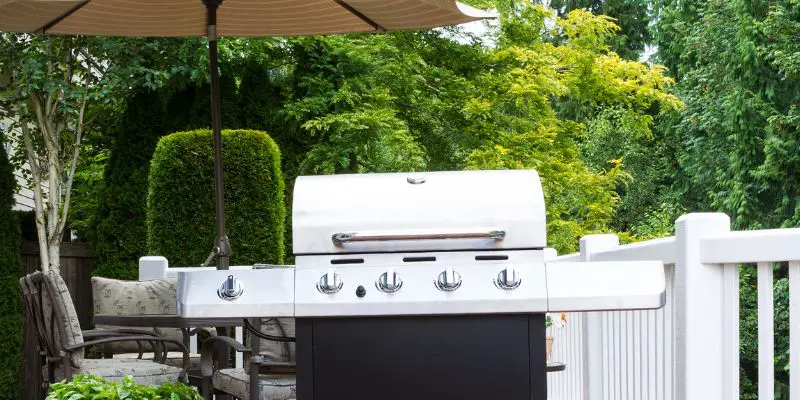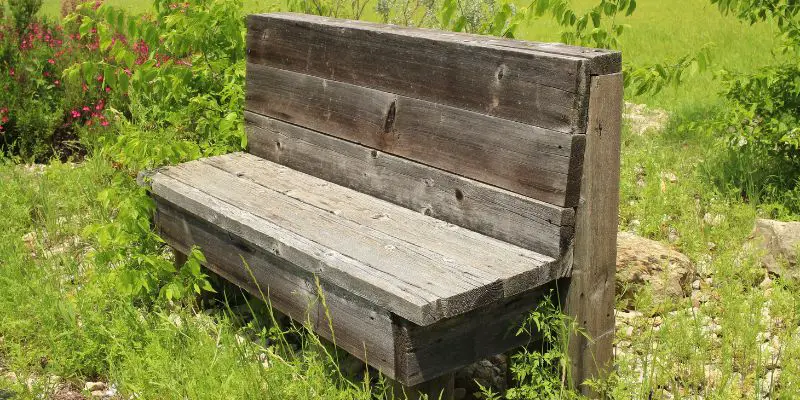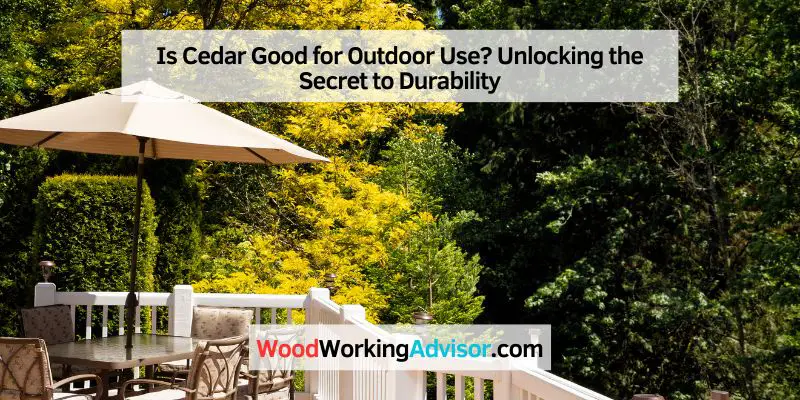Cedar is excellent for outdoor use because of its natural resistance to rot and insect damage. It is durable, weather-resistant, and requires minimal maintenance, making it a popular choice for outdoor projects.
Whether it’s for decking, fencing, siding, or furniture, cedar offers long-lasting beauty and functionality in any outdoor setting. Cedar is a fantastic option for outdoor use due to its natural resistance to rot and insects. Its durability, weather resistance, and low maintenance requirements make it a preferred choice for various outdoor projects.
From decking and fencing to siding and furniture, cedar provides enduring beauty and functionality in any outdoor environment. Its resistance to decay and bugs is a result of the natural oils and chemicals it contains. This makes cedar an ideal choice for long-lasting structures that can withstand harsh weather conditions and remain visually appealing. Additionally, the distinct aroma of cedar adds an extra layer of charm to outdoor spaces.
The Benefits Of Cedar Wood
Cedarwood is an excellent choice for outdoor use due to its numerous benefits. It possesses a natural resistance to decay and high durability, making it a popular option among homeowners and outdoor enthusiasts.
Natural Resistance To Decay
Cedar wood is naturally resistant to decay, making it an ideal choice for outdoor projects. Its natural oils act as a protective barrier against moisture, preventing rot and decay from taking hold. This natural resistance extends the lifespan of cedar wood, allowing it to withstand the elements year after year.
High Durability
In addition to its resistance to decay, cedar wood is highly durable. It has the ability to withstand harsh weather conditions without deteriorating or warping. This durability ensures that outdoor structures made from cedar wood, such as decks and fences, maintain their structural integrity and aesthetic appeal for an extended period.
Cedar wood’s impressive durability is attributed to its strength and stability. It contains natural preservatives, such as cedar oil, that protect against insects and fungal growth. As a result, cedar wood is less likely to experience the issues commonly associated with outdoor use, such as insect infestations and rot.
Moreover, cedar wood has a low shrinkage factor, meaning it remains stable and retains its shape even when exposed to varying humidity levels. This characteristic makes it highly desirable for outdoor projects that require dimensional stability over time. Whether it’s extreme heat, heavy rain, or freezing temperatures, cedar wood can withstand it all.
Furthermore, cedar wood’s durability also extends to its resistance to dents, scratches, and other forms of physical damage. This makes it an excellent choice for outdoor furniture, as it can withstand the rigors of regular use.
In conclusion, cedar wood is an exceptional material for outdoor use due to its natural resistance to decay and high durability. Its ability to resist rot, withstand harsh weather conditions, and maintain its strength and stability over time make it a popular choice among homeowners and outdoor enthusiasts. Consider utilizing cedar wood for your next outdoor project to benefit from its numerous advantages.

Factors Affecting Cedar’s Outdoor Performance
When it comes to choosing the right type of wood for your outdoor projects, cedar is often a top choice due to its natural beauty and durability. However, there are several factors that can affect how well cedar performs outdoors. In this article, we will explore these factors in detail, focusing on environmental conditions and maintenance.
Environmental Conditions
One of the key factors that can impact Cedar’s outdoor performance is the environmental conditions it is exposed to. Cedar is naturally resistant to rot, decay, and insect infestation, making it ideal for outdoor use. However, prolonged exposure to certain conditions can still affect its durability.
Moisture is one of the main threats to cedar’s performance. Excessive moisture can cause the wood to expand, contract, and eventually warp or crack. To prevent this, it is crucial to ensure proper drainage around any cedar structures and to regularly inspect and treat the wood with a water-repellent sealant.
Sun exposure is another environmental factor to consider. Over time, UV rays can cause the wood to fade and lose its natural color. To protect cedar from sun damage, applying a UV-resistant finish or stain regularly is recommended.
Maintenance
To keep cedar in optimal condition for outdoor use, regular maintenance is crucial. This includes cleaning the wood and applying protective treatments as needed.
Regular cleaning helps remove dirt, mildew, and other debris that can accumulate on the wood’s surface. It is best to use a mild soap solution and a soft brush or cloth to gently scrub the wood. Avoid using harsh chemicals or abrasive cleaning tools, as they can damage the wood and its natural oils.
After cleaning, applying a protective finish or stain can help enhance cedar’s resistance to the elements. A high-quality outdoor wood finish will provide an added layer of protection against moisture, UV rays, and other environmental factors.
In addition to regular cleaning and treatments, it is important to inspect cedar structures periodically for any signs of damage or wear. Catching and addressing issues early can help prolong the lifespan of the wood and prevent more extensive repairs or replacements.
To sum up, while cedar is a great choice for outdoor projects, the way it performs can be influenced by environmental conditions and the level of maintenance it receives. By considering these factors and taking the necessary precautions, you can ensure that cedar remains a durable and beautiful option for your outdoor spaces.
Comparing Cedar With Other Outdoor Woods
When it comes to choosing the right type of wood for outdoor use, it’s essential to consider the durability, resistance to elements, and overall quality of the material. Cedar is often a top choice for outdoor applications due to its natural resistance to decay and insects, but how does it compare to other popular outdoor woods like pine and redwood?
Cedar Vs. Pine
Cedar and pine are both commonly used for outdoor projects, but they have distinct differences. Let’s compare their key characteristics:
| Factor | Cedar | Pine |
|---|---|---|
| Durability | Cedar is naturally rot-resistant, making it highly durable for outdoor use. | Pine is more susceptible to decay and degradation, requiring regular maintenance. |
| Resistance to Insects | Cedar contains natural oils that act as insect repellents, offering better resistance to pests. | Pine is prone to insect infestations and may require chemical treatments for protection. |
| Color and Appearance | Cedar has a reddish-brown hue and a distinctive grain pattern, adding a natural aesthetic to outdoor spaces. | Pine has a lighter color and less pronounced grain, often requiring staining or painting for a desired look. |
Cedar Vs. Redwood
Redwood is another popular choice for outdoor construction, but how does it stack up against cedar? Let’s compare their features:
- Cedar is known for its natural resistance to decay and insect damage, reducing the need for chemical treatments.
- Redwood is also resistant to decay and insects, offering a similar level of durability for outdoor applications.
- Cedar’s distinct aroma and color make it a preferred option for many outdoor projects, adding a unique charm to the surroundings.
- Redwood boasts a rich, deep red hue and a smooth, elegant appearance, making it a prized material for outdoor furniture and decking.
Tips For Preserving Cedar’s Longevity
When it comes to outdoor use, cedar is an excellent choice for its natural durability and resistance to decay. To preserve its longevity, it’s advisable to regularly clean and seal the wood, as well as protect it from moisture and direct sunlight.
Applying a protective finish will help maintain cedar’s beauty and strength, ensuring it lasts for years in outdoor settings.
Preserving the longevity of cedar wood is crucial to ensure its durability and aesthetic appeal in outdoor use. By taking the right precautions, you can protect your cedar from various damaging factors, including weathering and rot. Here are some essential tips to help you maintain the beauty of cedar for years to come:
Sealants And Finishes
To protect your cedar from moisture damage and warping, applying sealants and finishes is a wise choice. These products act as a barrier against rain, snow, and humidity, preventing water from seeping into the wood fibers and causing decay. Before applying any sealant or finish, ensure that the cedar surface is clean and dry to maximize adhesion. Additionally, choose a sealant or finish specifically designed for outdoor use and cedar wood.
Proper Installation
Proper installation plays a significant role in preserving the longevity of cedar. When installing cedar for outdoor use, make sure to leave an appropriate gap between boards to allow for expansion and contraction due to changes in temperature and humidity. This helps prevent the boards from warping or cupping over time. Moreover, using stainless-steel or galvanized fasteners will minimize the risk of rust stains and ensure a secure hold.
Furthermore, it’s vital to keep the cedar wood away from direct contact with the ground. This can be achieved by installing a barrier, such as a plastic or metal strip, between the wood and the soil. This prevents moisture from being absorbed into the wood, reducing the chances of rot and decay.

Real-life Examples
Implementing cedar in outdoor settings has proved to be successful in various projects. Let’s explore some real-life examples:
Successful Implementation In Outdoor Settings
Cedar’s durability and natural resistance to decay make it an excellent choice for various outdoor applications.
- Garden Furniture: Cedar furniture, such as tables, chairs, and benches, can withstand outdoor elements and maintain their beauty for years.
- Decking: Cedar decking provides an attractive and long-lasting option for outdoor spaces. Its natural oils act as a barrier against moisture, preventing rot and insect damage.
- Exterior Siding: Many homeowners opt for cedar siding due to its ability to resist rot, decay, and insects. It adds a rustic and elegant touch to the exterior of homes.
Challenges Faced And Overcome
While cedar is known for its many advantages, there have been certain challenges in using it outdoors. However, these challenges can be effectively overcome.
- Weathering: Cedar can weather and turn gray over time when exposed to the elements. To combat this, regular maintenance, such as sealing or staining, can help preserve its natural color and protect it from environmental damage.
- Insect Infestation: Although cedar is naturally resistant to insects, it is not entirely immune. Proper cleaning and sealing can help prevent infestations and maintain the wood’s integrity.
- Cost: Cedar may have a higher initial cost compared to other wood options. However, its long-lasting nature and low maintenance requirements make it a wise investment in the long run.
Frequently Asked Questions Of Is Cedar Good For Outdoor Use
How Long Does Cedar Wood Last Outside?
Cedarwood can last a long time outside. It’s naturally resistant to rot, decay, and insect damage, making it durable and reliable. With proper maintenance and care, cedar wood can last for decades, making it an excellent choice for outdoor projects and structures.
Does Cedar Need To Be Treated For Outdoor Use?
Cedar does not need to be treated for outdoor use.
How Do You Protect Cedar Wood Outside?
Protect cedar wood outside by applying a clear sealant or oil-based stain. Clean the wood regularly to remove dirt and debris. Shield it from direct sunlight and harsh weather conditions. Use protective covers or shelters for longer-term protection. Implement regular maintenance to preserve the wood’s natural beauty and durability.
What Is The Best Wood For Outdoor Use?
The best wood for outdoor use is typically hardwoods like teak, cedar, or redwood. Hardwoods are naturally resistant to weathering, decay, and insect damage, making them durable for outdoor furniture, decks, and structures. Hardwoods also have a beautiful appearance and can be treated with protective oils or stains.
Conclusion
Cedar is an excellent choice for outdoor use due to its natural resistance to decay, insects, and rot. Its beautiful aesthetic and low maintenance requirements make it a popular choice for decks, fences, and other outdoor structures. Consider cedar for your next outdoor project for durability and long-lasting beauty.


